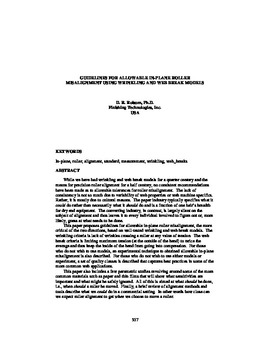| dc.contributor.author | Roisum, D. R. | |
| dc.contributor.other | International Conference on Web Handling (2013) | |
| dc.date.accessioned | 2019-11-12T14:57:35Z | |
| dc.date.available | 2019-11-12T14:57:35Z | |
| dc.date.issued | 2013-06 | |
| dc.identifier | oksd_icwh_2013_roisum | |
| dc.identifier.citation | Roisum, D. R. (2013, June). Guidelines for allowable in-plane roller misalignment using wrinkling and web break models. Paper presented at the Twelfth International Conference on Web Handling (IWEB), Stillwater, OK. | |
| dc.identifier.uri | https://hdl.handle.net/11244/322010 | |
| dc.description.abstract | While we have had wrinkling and web break models for a quarter century and the means for precision roller alignment for a half century, no consistent recommendations have been made as to allowable tolerances for roller misalignment. The lack of consistency is not so much due to variability of web properties or web machine specifics. Rather, it is mostly due to cultural reasons. The paper industry typically specifies what it could do rather than necessarily what it should do and is a fraction of one hair's breadth for dry end equipment. The converting industry, in contrast, is largely silent on the subject of alignment and thus leaves it to every individual involved to figure out or, more likely, guess at what needs to be done. | |
| dc.description.abstract | This paper proposes guidelines for allowable in-plane roller misalignment, the more critical of the two directions, based on well-tested wrinkling and web break models. The wrinkling criteria is lack of wrinkles crossing a roller at any value of tension. The web break criteria is limiting maximum tension (at the outside of the bend) to twice the average and thus keep the inside of the bend from going into compression. For those who do not wish to use models, an experimental technique to obtained allowable in-plane misalignment is also described. For those who do not wish to use either models or experiment, a set of quality classes is described that captures best practices in some of the more common web applications. | |
| dc.description.abstract | This paper also includes a few parametric studies revolving around some of the more common materials such as paper and thin films that will show what sensitivities are important and what might be safely ignored. All of this is aimed at what should be done, i.e., when should a roller be moved. Finally, a brief review of alignment methods and tools describe what we could do in a commercial setting. In other words how close can we expect roller alignment to get when we choose to move a roller. | |
| dc.format | application/pdf | |
| dc.language | en_US | |
| dc.publisher | Oklahoma State University | |
| dc.rights | In the Oklahoma State University Library's institutional repository this paper is made available through the open access principles and the terms of agreement/consent between the author(s) and the publisher. The permission policy on the use, reproduction or distribution of the article falls under fair use for educational, scholarship, and research purposes. Contact Digital Resources and Discovery Services at lib-dls@okstate.edu or 405-744-9161 for further information. | |
| dc.title | Guidelines for allowable in-plane roller misalignment using wrinkling and web break models | |
| osu.filename | oksd_icwh_2013_roisum.pdf | |
| dc.type.genre | Conference proceedings | |
| dc.type.material | Text | |
| dc.subject.keywords | in-plane | |
| dc.subject.keywords | roller | |
| dc.subject.keywords | alignment | |
| dc.subject.keywords | standard | |
| dc.subject.keywords | measurement | |
| dc.subject.keywords | wrinkling | |
| dc.subject.keywords | web breaks | |
